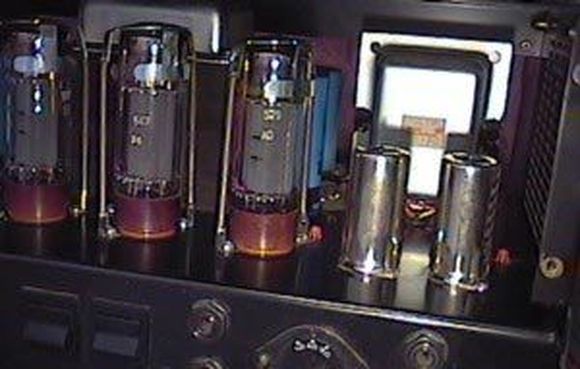2. History
Guitar amplification has evolved in parallel with the electric guitar itself. The need for amplification arose as dance and swing bands grew louder in the early part of the Twentieth century as more instruments and more noisy instruments were added. Though most rhythm sections included a guitar, what was at the time a purely acoustic instrument struggled to be heard above the horns and drums. A single sax or trumpet is considerably louder than an acoustic guitar, so its no surprise that as swing bands expanded to include four or five of each, the guitar was restricted to almost subliminal background rhythm work.
From a present-day perspective, it seems a happy accident that guitar amplification was developed before the technological advances that made high fidelity amplification possible. The original design goal was simply to amplify the acoustic guitars sound without changing its character, but Fortunately for us, the components available in the Thirties and Forties were simply not up to the job. Early recordings of the electric guitar, though not nearly as far removed from the sound of the acoustic instrument as the rock guitar sounds of later decades, feature a distinctive honking sound - the result of a number of factors including slight distortion, compression, and a technically very poor frequency response - the basic components of the rock guitar sound were already in place!
By the mid Sixties, the electric guitar was a well-established instrument, and central to most popular music on both sides of the Atlantic. However, guitar amplification still lagged behind in some respects - the popular bands of the day were playing to large audiences of teenagers, who far from listening in respectful silence, tended to scream hysterically - guitarists were forced to turn their modestly powered amplifiers up to maximum volume
Any analogue audio circuit will produce distortion if driven hard enough. In hi-fi terms this is considered undesirable - hi-fi amps are often marketed in terms of how little distortion they produce at maximum volume. But as guitar players in the Sixties began to turn their amps up louder and louder, many of them discovered that they actually rather liked the resulting distortion.
The basic component of most electronic equipment until around this time, the thermionic valve (also known as the vacuum tube), would generally soon be superseded by the transistor. Transistors are superior to valves in almost all respects, being far smaller, cheaper and more reliable. The silicon chip, which is an array of thousands or even millions of transistors, is in general better still. But guitar players first encountered distortion at a time when valves still held sway, and certain types of valves beat transistors in one crucial respect - they produce subjectively pleasing distortion. Valves are still used today, because although guitar amp manufacturers were as keen as anyone to switch to transistors, guitarists kept insisting that they just didnt sound as good when overdriven. To the extent that decent-sounding transistor amps do exist, this is because much work has been done to understand why valves sound so good and to develop ways to mimic them.
Because distortion was initially an unintended consequence of amplifier design, there was no way to achieve it without turning up to deafening levels. Until the late Sixties, guitar amps had only one volume control which controlled the signal level all the way through several stages of amplification. In other words, your sound could be either clean and quiet, or loud and dirty. Obviously this became a problem as the distorted sounds popularity increased - many players wanted to use distortion on smaller gigs, or at home, without damaging their hearing or irritating their neighbours. Two solutions to this problem arrived at around the same time -the distortion pedal (initially known as the fuzz box), and the master volume control.
The idea behind the fuzz box was to produce distortion or fuzz in an external unit before feeding it to the amplifier. While early fuzz boxes used the new transistor technology, and thus failed to duplicate the sound of valve distortion, they were of course usually connected to valve amps, which smoothed out their sound somewhat, and various classic fuzz box sounds, not all of which sound like a wasp in a jam jar, can be heard on records of this era.
The master volume control, pioneered by Marshall, was more generally useful, the idea being that distortion could be produced at the pre-amplifier stage (where the basic sound is shaped), with a separate volume control at the power amp stage (where the signal is stepped up to a sufficient level to drive a loudspeaker). Almost all guitar amps make use of this concept today, and therefore usually have a gain control (which affects both distortion and volume), and a master volume control governing the overall level.



